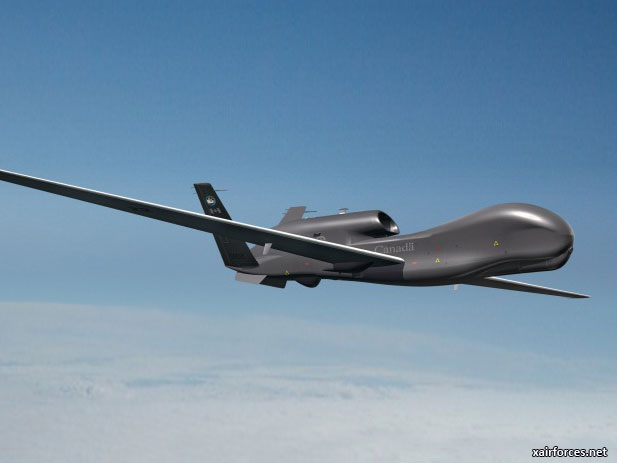
Canadian Military to Spend $1 Billion on Armed UAVs

Senior Canadian defence leaders pitched the idea of spending up to $600 million for armed drones to take part in the Libyan war shortly before the conflict ended, according to documents obtained by the Citizen.
And while the death of Libyan leader Colonel Moammar Gadhafi effectively ended the war and scuttled the Defence Department’s plans, the military has now relaunched its program to purchase unmanned aerial vehicles (UAVs) that can be outfitted with missiles and bombs. According to DND documents the military intends to spend around $1 billion on the project.
The Conservative government approved last month the issuing of a request to aerospace firms to provide details about the types of drones now available. Companies have until Sept. 28 to provide the information.
In its request to the industry, the government pointed out the need for the unmanned aircraft to operate in the Arctic. The aircraft should also be able to carry precision-guided munitions, the government said.
“This capability will allow the CF (Canadian Forces) to fill critical deficiencies,” industry officials were told in the request for information sent to them July 23.
The Canadian Forces has used unarmed UAVs at various stages during the Afghan war. But it has been trying to purchase a new fleet of armed drones for years.
In 2007, the Citizen reported the Defence Department had asked the Conservative government for approval to buy the American-built Predator drones for the Afghanistan mission. That request was denied because of concerns in cabinet and the federal bureaucracy that the deal would be non-competitive.
The government eventually approved the lease of Israeli-built UAVs from MacDonald Dettwiler and Associates in Richmond, B.C. Those unarmed Heron aircraft operated out of Kandahar Airfield.
DND started its project to purchase armed UAVs in 2008 but that stalled because funding had to be diverted to other equipment programs.
Documents obtained by the Citizen show that military leaders saw the Libyan war as a possible way to move its stalled UAV program forward. According to a briefing presented Aug. 16, 2011 to Defence Minister Peter MacKay, they pointed out that the purchase of such aircraft for the Libyan conflict could kick start their larger project to buy UAVs for both domestic and international missions.
Responding to high-level government discussions on ways to address future operational needs for the war, Canadian Forces planners detailed a proposal to purchase a fleet of armed unmanned aerial vehicles at a cost of roughly $600 million.
While that was expected to take up to a year, they also outlined a concurrent proposal to obtain on loan a fleet of such aircraft that could be sent into battle almost immediately.
“Using loaned assets and personnel, a UAV capability with the ability to start operations within the next (censored) is feasible,” according to the briefing. “However, this would require complete government commitment and support from (name of country censored).”
The briefing, provided to MacKay by DND deputy minister Robert Fonberg and Chief of the Defence Staff Gen. Walter Natynczyk, was obtained by the Citizen through the Access to Information law.
“There are currently limited options available for a weaponized UAV, a crucial requirement for this and future operations,” the briefing noted.
The United States is the main country operating UAVs capable of carrying weapons.
The Libyan war, however, was in its final stages when the briefing was provided. The capital, Tripoli, fell by the end of August and Gaddafi’s regime was near collapse. He was killed Oct. 20.
The U.S. began using armed Predator drones in the Libyan war in April. From that month until October the Predators conducted 145 attacks, according to the Pentagon.
A Predator was also used to launch an attack on a convoy carrying Gadhafi as he was trying to flee the city of Sirte. That paved the way for Libyan rebel fighters to capture the colonel. The former leader of Libya was tortured and killed shortly after with a shot to the head.
NATO officers said after the war they could have used more UAVs to provide surveillance as well as to attack targets.
At least one company is already looking to provide UAVs to the Canadian Forces.
In May, the U.S. aerospace firm, Northrop Grumman, announced at a military trade show in Ottawa that it had made an unsolicited pitch to the Conservative government for the purchase of a fleet of Global Hawk unmanned aerial vehicles. Those would be used for a variety of missions and to provide surveillance along Canada’s coastlines, in particular, in the Arctic.
The aircraft could operate from Goose Bay, N.L., Montreal, or Comox, B.C., the company suggested.
The Global Hawk is capable of staying aloft for up to 35 hours, transmitting video to ground stations during its flight. Unlike the Predator, it is only for surveillance and is not armed.
Source: Unmanned Aerial Vehicles (UAV) News - 07 August 2012
Photo: The Canadian RQ-4 Global Hawk (Photo by gizmag.com)
(7.08.2012)
|